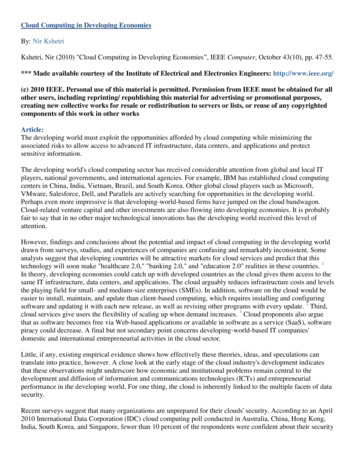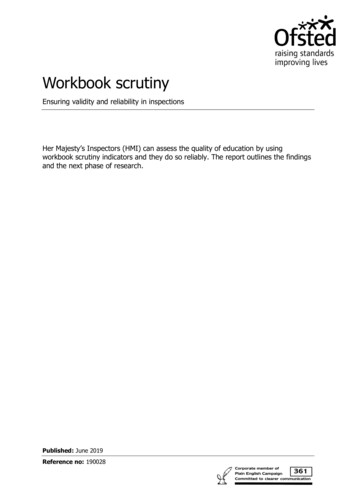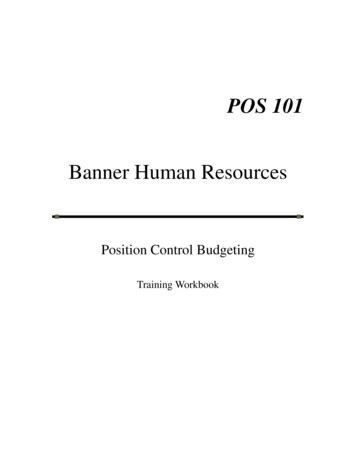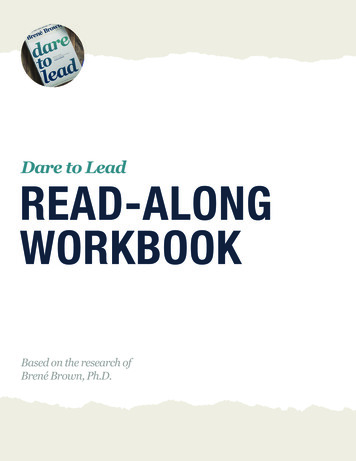
Transcription
SUP P LE ME N TA LWOR KB OOKCopyright 2014 Nir Eyal, NirAndFar.com. All rights reserved.HOOKED WORKBOOK CHAPTER X1
SPECIAL OFFERBuy Hooked now and receive a special book bundle. You’ll receive four valuable resources tohelp you build habits in yourself and your userFirst, buy your copy of Hooked by clicking a retailer below, then rnes & NoblesIndieBound.orgTESTIMONIALSStephen P. AndersonAuthor of “Seductive Interaction Design”Andrew ChenTechnology Writer & Investor“You’ll read this. Then you’ll hope yourcompetition isn’t reading this.It’s that good.”“When it comes to driving engagementand building habits, Hooked is anexcellent guide into the mind of theuser.”Dave McClureFounder of 500 startups“Nir’s work is an essential crib sheet forany startup looking to understand userpsychology.”“This is the absolute best book on product development I've ever read.”J. Walnes 220 reviewers made a similar statement“If you read one “product book” this year, make sure it’s this one.”Daniel J Groch 68 reviewers made a similar statement“A must-read! Super inspiring and down-to-earth.”Zornitsa Tomova 36 reviewers made a similar statement
INTRODUCTIONNote from the Author:One of the key lessons I stress in my book, Hooked: How to Build Habit-Forming Products, is theimportance of simplicity. When a behavior is easier to do, it is more likely people will do it.Hence, if I wanted people to act upon what they read in my book, I needed to find a way tosimplify the action I wanted them to take. This supplemental workbook is designed to guide youthrough thinking and applying the lesson in Hooked to your own business. It is not a replacementfor the book of course, but rather a place to reinforce the main ideas and digest what you’velearned.Though not exhaustive, lessons from select chapters are bullet-pointed and come withaccompanying exercises to guide you through the steps of designing a habit-forming product orservice of your own. By the end this workbook, you should have a deeper understanding of theHooked Model and a set of hypotheses you can test to make your product or service moreengaging.I wish you great success and hope you will use what you learn to build things that move people!Sincerely,Nir EyalNirAndFar.comHOOKED SUPPLEMENTAL WORKBOOK2
THE BASICS OF HABITSRemember this: Habits are defined as “behaviors done with little or no conscious thought” The Hooked Model has four phases: trigger, action, variable reward, and investment.(Figure 1) Hooks are experiences designed to connect the user’s problem to a solution frequentlyenough to form a habit To form a habit, people must do the behavior frequently.Note: Make sure you read the introduction and first chapter of Hooked tofully understand these concepts before completing the exercises next.Figure 1: The Hooked ModelHOOKED SUPPLEMENTAL WORKBOOK4
EXERCISE 1:1.) Select the product or service you want to make more engaging. We will use this project forall the subsequent exercises. Write down the name of the project here:2.) Why does your business model require users form a habit?3.) What problem are users solving with your product?4.) How do users currently solve that problem and why does it need a solution?5.) What is the user behavior you want to turn into a habit? (the intended habitual behavior)HOOKED SUPPLEMENTAL WORKBOOK5
6.) How frequently do you expect users to engage with your product?(Note: If the behavior does not occur within a week’s time or less, you may have a very difficult time forming a habit.)HOOKED SUPPLEMENTAL WORKBOOK6
TRIGGERSRemember this: Triggers cue the user to take action and are the first step in the Hooked Model. Triggers come in two types—external and internal.» External triggers tell the user what to do next by placing information within theuser’s environment.» Internal triggers tell the user what to do next through associations stored in theuser’s memory. Negative emotions frequently serve as internal triggers. Be sure to understand which user emotions may be tied to internal triggers and knowhow to leverage external triggers to drive the user to action.Note: Make sure you read the second chapter of Hooked to fullyunderstand these concepts before completing the exercises next.HOOKED SUPPLEMENTAL WORKBOOK7
EXERCISE 2:1.) Who is your product’s user? Be clear about the person you intend to help form a habit.Can you name a real person you know that needs your product?2.) What is the user doing right before he or she does the intended habitual behavior youdefined in Exercise 1?3.) Using the 5 Whys technique described in the book, come up with three internal triggers thatcould cue your user to action.4.) What internal trigger does your user experience most often?HOOKED SUPPLEMENTAL WORKBOOK8
5.) Using your most frequent internal trigger and the intended habitual behavior you describedin Exercise 1, finish the brief narrative belowEvery time the user(internal trigger), he/she (intended habitual behavior).For example: Every time the Jenny feels bored, she opens the Facebook app on her phone.6.) Referring back to question 2, what might be the best places and times to display anexternal trigger?7.) How can you time your external trigger so that it fires as closely as possible to when youruser experiences their internal trigger?8.) Think of at least three conventional ways (e-mails, direct mail, text messages, etc.)and three crazy or currently impossible ways (wearable computers, biometric sensors,carrier pigeons, etc.) to trigger your user with an external trigger the moment he or sheexperiences the internal trigger.HOOKED SUPPLEMENTAL WORKBOOK9
ACTIONRemember this: The second step in the Hooked Model is the Action. The action is the simplest behavior in anticipation of reward. Dr. B. J. Fogg’s Behavior Model says:» For any behavior to occur, a trigger must be present at the same time as the user hassufficient ability and motivation to take action.» To increase the desired behavior, ensure a clear trigger is present; next, increase abilityby making the action easier to do; finally, align with the right motivator.» Every behavior is driven by one of three Core Motivators: Seeking pleasure and avoiding pain Seeking hope and avoiding fear Seeking social acceptance while avoiding social rejection.» Ability is user and context dependent and is influenced by six factors: time,money, physical effort, brain cycles, social deviance, and non-routineness. Heuristics are cognitive shortcuts we take to make quick decisions. Product designerscan utilize many of the hundreds of heuristics to increase the likelihood of their intendedhabitual behavior.Note: Make sure you read the third chapter of Hooked to fullyunderstand these concepts before completing the exercises next.HOOKED SUPPLEMENTAL WORKBOOK10
EXERCISE 3:1.) Starting from the time your user feels their internal trigger, count the number of steps ittakes to reach the expected outcome.a. How does this process compare with the simplicity of some of the examplesdescribed in chapter 3 of Hooked?b. How does this compare with competitors’ products and services?2.) What is limiting your users’ ability to accomplish the intended habitual behavior?(Circle all that apply)TimeSocial deviance (outside the norm)Brain cycles (too confusing)Physical effortMoneyNon-routine (too new)3.) Brainstorm three testable ways you can make the intended habitual behavior easier tocomplete by removing the barriers you circled above. Consider how you might applyheuristics to make the intended behavior more likely.HOOKED SUPPLEMENTAL WORKBOOK11
VARIABLE REWARDRemember this: Variable reward is the third phase of the Hooked Model» Rewards of the tribe: the search for social rewards fueled by connectedness with otherpeople.» Rewards of the hunt: the search for material resources and information.» Rewards of the self: the search for intrinsic rewards of mastery, competence,and completion.Note: Make sure you read the fourth chapter of Hooked to fullyunderstand these concepts before completing the exercises next.HOOKED SUPPLEMENTAL WORKBOOK12
EXERCISE 4:1.) Speak with five of your customers or users in an open-ended interview; identify whatthey find enjoyable or encouraging about using your product. Make note of any momentsof delight or surprise. Is there anything they find particularly satisfying about using theproduct?2.) Review the steps your customer takes to use your product or service habitually inExercise 3. What outcome (reward) alleviates the user’s pain? Is the reward fulfilling?Does it leave the user wanting more?3.) Brainstorm three ways your product might heighten users’ search for variable rewardsusing the variable reward types below:a. Rewards of the tribeb. Rewards of the huntc. Rewards of the selfHOOKED SUPPLEMENTAL WORKBOOK13
INVESTMENTRemember this: The investment phase is the fourth step in the Hooked Model.» Unlike the action phase, which delivers immediate gratification, the investment phaseconcerns the expectation of a future benefit. Investments in a product influence customer preferences because people tend to:overvalue their work, seek to be consistent with past behaviors, and avoid cognitive dissonance. Investments increase the likelihood of users returning by improving the service the more it isused. Investments “store value” in the form of content, data, followers, reputation, and skill. Investments increase the likelihood of users passing through the Hook again by loading thenext trigger to start the cycle all over again.Note: Make sure you read the fifth chapter of Hooked to fullyunderstand these concepts before completing the exercises next.HOOKED SUPPLEMENTAL WORKBOOK14
EXERCISE 5:1.) Review your flow. What “bit of work” are your users doing to increase their likelihoodof returning?2.) Brainstorm three ways to add small investments into your product to:a. Load the next trigger.b. Store value as data, content, followers, reputation, and skill.3.) Identify how long it takes for a “loaded trigger” to reengage your users.How can you reduce the delay to shorten time spent cycling through the Hook?4.) Now that you have several testable ways to improve your product or service from doingthese exercises, write down which insight from this book you would like to implement first.HOOKED SUPPLEMENTAL WORKBOOK15
WHAT ARE YOU GOING TO DO WITH THIS?Remember this: To help you assess the morality behind how you influence users behavior, it is helpful todetermine which of the four categories your work fits into.Note: Make sure you read the sixth chapter of Hooked to fullyunderstand these concepts before completing the exercises next.HOOKED SUPPLEMENTAL WORKBOOK16
EXERCISE 6:1.) Take a minute to consider where you fall on the Manipulation Matrix.a. Do you use your own product or service?b. Do you believe that the behavior you are designing materially improves people’slives? Why or why not?2.) Are you a facilitator, peddler, dealer, or entertainer? Are you comfortable with whereyou are on the manipulation matrix?HOOKED SUPPLEMENTAL WORKBOOK17
HABIT TESTING AND WHERE TO LOOKFOR HABIT-FORMING OOPPORTUNITIESRemember this: The Hooked Model helps uncover potential weaknesses in an existing product’s habitforming potential. Once a product is built, Habit Testing helps: uncover product devotees, discover whichproduct elements (if any) are habit forming, and why those aspects of your productchange user behavior. Habit Testing includes three steps: identify, codify, and modify. Identifying areas where a new technology makes cycling through the Hooked Modelfaster, more frequent, or more rewarding provides fertile ground for developing newhabit-forming products. Nascent behaviors are new behaviors that few people see or do yet ultimately fulfill amass-market need.Note: Make sure you read the seventh chapter of Hooked to fullyunderstand these concepts before completing the exercises next.HOOKED SUPPLEMENTAL WORKBOOK18
EXERCISE 7:If you have an existing product or service, ask yourself the following questions:(Note that answering these questions requires collecting and analyzing user data.)1) How frequently would you expect a habituated user to interact with your product or service?(Refer back to your answer to Question 6 in Exercise 1.)2) What percentage of users used your product habitually over the past 60 days?3) What is unique about these habituated users? What did they do with your products thatnon-habituated users did not?4) Can you modify the experience users have with your product so that all users take the sameactions as your habituated users?HOOKED SUPPLEMENTAL WORKBOOK19
This next exercise will help sharpen your ability to find new opportunities forhabit-forming products and requires some field research.1.) During the next week, be aware of your behaviors and emotions as you use everydayproducts or services. Now that you know the phases of the Hooked Model, consider howthese things could be made more habit-forming.a. Write down a product or service you observed yourself using habitually (with littleor no conscious thought) over the course of the week.b. What triggered you to use the product? Were you prompted externally or throughinternal means?c. How could it be made easier to use?d. How could it be designed for more frequent use?HOOKED SUPPLEMENTAL WORKBOOK20
e. How could it be made more rewarding?f. How might it solicit more user investment to make the product better with useand load the next trigger?2.) Think of a product you used this week in a way the maker had not intended. How didyou modify the product? Consider if this nascent behavior might appeal to others andwarrants a product of its own?3.) Observe your target user and see what products or services they modify to meet theirneeds in unique ways (this is fertile ground for innovation!). Can your product or serviceturn a few customers’ modifications into a solution with wider appeal?HOOKED SUPPLEMENTAL WORKBOOK21
SPECIAL OFFERBuy Hooked now and receive a special book bundle. You’ll receive four valuable resources tohelp you build habits in yourself and your userFirst, buy your copy of Hooked by clicking a retailer below, then rnes & NoblesIndieBound.orgTESTIMONIALSStephen P. AndersonAuthor of “Seductive Interaction Design”Andrew ChenTechnology Writer & Investor“You’ll read this. Then you’ll hope yourcompetition isn’t reading this.It’s that good.”“When it comes to driving engagementand building habits, Hooked is anexcellent guide into the mind of theuser.”Dave McClureFounder of 500 startups“Nir’s work is an essential crib sheet forany startup looking to understand userpsychology.”“The book, very easy to read and understand the topic.”Radek Vacha 97 reviewers made a similar statement“If you read one “product book” this year, make sure it’s this one.”Mr Daniel J Groch 68 reviewers made a similar statement“Nir shares some great insight that I applied in my product design.”Cyril Labidi 52 reviewers made a similar statement
TRIGGERS Remember this: Triggers come in two types—external and internal. » External triggers tell the user what to do next by placing information within the user’s environment. » Internal triggers tell the user what to do next through associations stored in the user’s memory. Negative emotion










